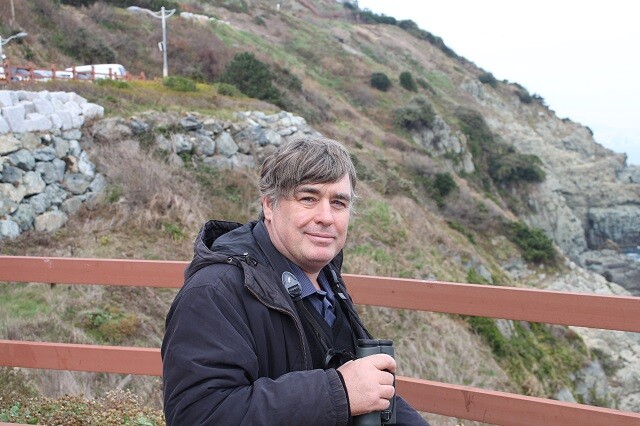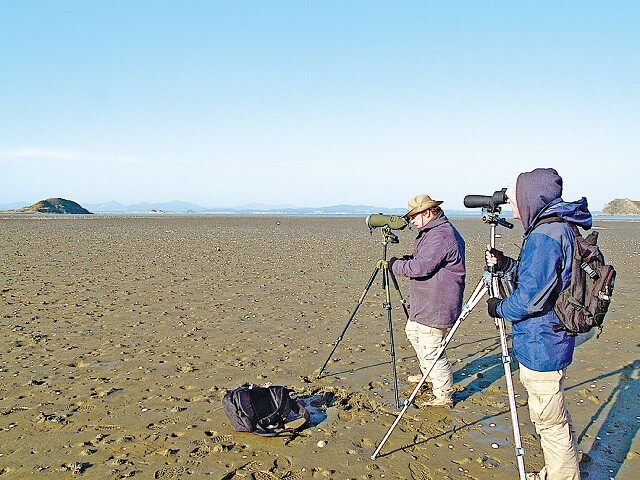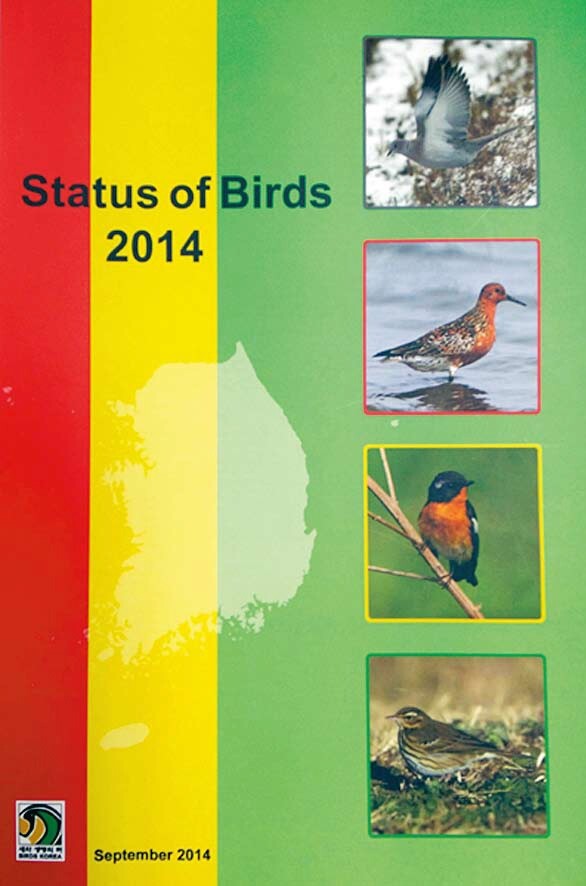hankyoreh
Links to other country sites 다른 나라 사이트 링크
One Briton’s 50-year romance with birds brings him to a life in Korea

At the end of every story the man told about the Saemangeum Seawall, the word “heartbreaking” appeared like a chorus.
Four months from now, it will be exactly 10 years since construction ended on the final stretch of the seawall that choked the Saemangeum mudflats.
But for Nial Moores, the 52-year-old director of Birds Korea (http://www.birdskorea.org/ ) - an environmental group that works for the conservation of birds and their habitats - Saemangeum appears to ache with a pain that time cannot dull.
“Have you heard of the great knot?” Without waiting for a reply, he continued. “The first time I saw that bird at Saemangeum, it was ranked as ‘least concern’ on the IUCN Red List.”
The Red List of Threatened Species is maintained by the International Union for Conservation of Nature.
“Today, it has gone past ‘vulnerable’ and is categorized as ‘endangered.’ The same thing happened to the Far Eastern curlew. At this rate, many birds that depend on the mudflats at Saemangeum and other parts of the Yellow Sea coast will go extinct within a generation.”
Soon after Moores started talking about birds and wetlands on Dec. 2, on a hill below a coastal ecological park in the Nam District of Busan, from which Oryukdo Island is visible, the topic turned to Saemangeum.
“Since the Saemangeum Seawall was finished in 2006, the mudflats have died, fishermen have lost their jobs, and the population of birds on the mudflats has plummeted. But who’s talking about Saemangeum today?”
Over 200 visits to the Saemangeum
In the late 1990s, Saemangeum was a hot topic in South Korean society. At the time, there was a blue-eyed young man who could be seen at nearly all of the seminars and debates that were organized by environmental groups to bring attention to the need for conserving the Saemangeum mudflats. This young man was Nial Moores from Liverpool.
What got people‘s attention was that Moores was not in the audience but rather at the lectern or among the debaters. Also, the topics that Moores covered were not case studies from the UK but rather the current state of wetlands and birds in South Korea, things that even South Koreans know little about.
During the 1990s, Moores lived in Fukuoka, Japan, working as an English teacher at night and as a bird expert for wetland conservation organizations during the day. He made occasional birdwatching trips to South Korea. Then in 1998, he moved to South Korea to help environmental groups there in their work to preserve the wetlands.
He had been a high school teacher in the UK when he responded to a call for help in preserving the wetlands from a Japanese environmental group and boarded a plane bound for Japan. Some of the factors driving his move were his interest in experiencing a different culture and his desire to see a spoon-billed sandpiper with his own eyes-until then, he had only seen it in pictures.
The spoon-billed sandpiper, which is only observed in the mudflats of Asian countries such as South Korea, China, and Japan, is a globally endangered species. Today, only around 300 remain in the whole world.
In South Korea, Moores initially explored the mudflats of the southwest coast as a bird expert with a wetland conservation alliance, composed of environmental groups. Then in 2001, he played a leading role in establishing a group called Friends of Birds and Wetlands; in 2004, he founded Birds Korea.
Moores did not agree with environmental activists who focused on campaigns in which they attacked policymakers and called for policy change. He thought that the role of NGOs should be focused on producing information and data and providing this to the policymakers-who, after all, had been entrusted with authority by the electorate-so that those policymakers could make the best possible decisions. This attitude led to a rift between him and environmental activists in South Korea.
Moores had picked up this approach from his observations of the relationship that UK environmental organizations such as the Royal Society for the Protection of Birds (RSPB) had with policymakers. In South Korea, though, it got him nowhere.
Using data that he had compiled by tirelessly tracking the routes of migratory birds, he promoted the ecological value of the mudflats on the southwest coast both in South Korea and overseas.
Heartbreak over disappearing mudflats
But when he presented the results of his painstaking research-which involved more than 200 trips to Saemangeum alone-to the South Korean government officials involved in decision making, they either ignored him or tried to dismiss his findings.
“I prepare reports analyzing the data, I write articles explaining the reports, I make presentations about this-what else can I do?” Moores said with exasperation in his voice and weariness on his face.
Moores had been planning to live in South Korea for about five years, but so far, he has been here for 18 years.
“When I first came to Korea in 1998, the situation was all right. The government and NGOs had a decent relationship. Just a year earlier, Korea had joined the Ramsar Convention, which promotes the conservation of habitats for waterfowl. Since it was undeniable that the Saemangeum mudflats were immensely valuable as a waterfowl habitat, I expected that, in five years or so, greater awareness of mudflat conservation would bring the Saemangeum project to a halt,” he said. But this expectation was proved wrong.
Moores was severely disappointed. Watching the Four Major Rivers Project unfold, he started to despair.
“What I want is for the next generation of South Koreans to get to see the scaly-sided merganser and the spoon-billed sandpiper. This means that the rivers need to stay healthy and the mudflats need to keep thriving. That’s all I want, but now, to be honest, I‘m starting to feel frustrated,” he admitted.
So what is it that, despite all of this, prevents him from leaving South Korea?
“I hope this doesn’t sound too arrogant,” he began cautiously. “As I’ve watched the destruction of the mudflats and the wetlands that is happening in South Korea, I’ve felt a great responsibility as an expert. I’ve come to think that there’s nothing more important to dedicate my life to than doing my part to help protect the birds and their habitats in this region.”
Moores’ keen interest in birds goes back to the age of four. He was born with 95% of his hearing impaired. Belatedly realizing this, his parents took him to the hospital. When he returned home after an operation and lay down in bed to go to sleep, he heard a strange sound.
“This sound that I was hearing for the first time was so wonderful. It sounded like an angel was blowing its trumpet. Even though this happened when I was four years old, nearly 50 years ago, the excitement I felt then is still with me today,” Moores said.
Running up to Moores’ room when they heard their boy’s shouts of excitement, they told him that the sound was the honking of geese flying above the roof of the house.
That mysterious experience marked the beginning of Moores’ romance with the creatures known as birds, a romance that has lasted for nearly 50 years.
A major report, not attempted in China, Russia, or Japan
Just in time for the twelfth conference of the parties to the Convention on Biological Diversity (CBD), held in Pyeongchang, Gangwon Province in Sep. 2014, Birds Korea, the organization led by Moores, released a report called Status of Birds 2014. The report analyzes the current status of South Korea‘s birds, using the results of bird research Moores had conducted and material published in South Korea and other countries up to that point.
“This was a meaningful and important report that had not been attempted in China, Russia, or Japan,” Moores said.
In the future Moore would like to keep revising this report while carrying out a basic survey of the status of birds and their habitats across the entire Korean Peninsula, including North Korea.
“In order to determine the influence that humans and climate change are having on biological diversity, we need some basic data, but so far there are no comprehensive reports on the distribution of birds across North Korea and the rest of the Korean Peninsula,” Moores said.
“Since this kind of research project would take about two or three years to do, it isn’t feasible for ornithologists in North and South Korea, who have trouble crossing the border. I would like Birds Korea to play an important role in this. That’s my dream,” he said.
By Kim Jeong-su, senior staff writer
Please direct questions or comments to [english@hani.co.kr]

Editorial・opinion
![[Column] Season 2 of special prosecutor probe may be coming to Korea soon [Column] Season 2 of special prosecutor probe may be coming to Korea soon](https://flexible.img.hani.co.kr/flexible/normal/500/300/imgdb/original/2024/0426/3317141030699447.jpg) [Column] Season 2 of special prosecutor probe may be coming to Korea soon
[Column] Season 2 of special prosecutor probe may be coming to Korea soon![[Column] Park Geun-hye déjà vu in Yoon Suk-yeol [Column] Park Geun-hye déjà vu in Yoon Suk-yeol](https://flexible.img.hani.co.kr/flexible/normal/500/300/imgdb/original/2024/0424/651713945113788.jpg) [Column] Park Geun-hye déjà vu in Yoon Suk-yeol
[Column] Park Geun-hye déjà vu in Yoon Suk-yeol- [Editorial] New weight of N. Korea’s nuclear threats makes dialogue all the more urgent
- [Guest essay] The real reason Korea’s new right wants to dub Rhee a founding father
- [Column] ‘Choson’: Is it time we start referring to N. Korea in its own terms?
- [Editorial] Japan’s rewriting of history with Korea has gone too far
- [Column] The president’s questionable capacity for dialogue
- [Column] Are chaebol firms just pizza pies for families to divvy up as they please?
- [Column] Has Korea, too, crossed the Rubicon on China?
- [Correspondent’s column] In Japan’s alliance with US, echoes of its past alliances with UK
Most viewed articles
- 1Is Japan about to snatch control of Line messenger from Korea’s Naver?
- 2‘We must say no’: Seoul defense chief on Korean, USFK involvement in hypothetical Taiwan crisis
- 3S. Korea “monitoring developments” after report of secret Chinese police station in Seoul
- 4The dream K-drama boyfriend stealing hearts and screens in Japan
- 5Division commander ordered troops to enter raging flood waters before Marine died, survivor says
- 6[Editorial] New weight of N. Korea’s nuclear threats makes dialogue all the more urgent
- 7No good, very bad game for Korea puts it out of Olympics for first time since 1988
- 8[Column] ‘Choson’: Is it time we start referring to N. Korea in its own terms?
- 9‘Weddingflation’ breaks the bank for Korean couples-to-be
- 10[Column] Season 2 of special prosecutor probe may be coming to Korea soon